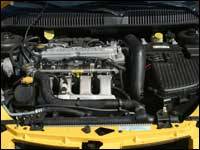 |
| 2005 Dodge SRT-4 (Photo: DaimlerChrysler Canada) |
Boost involves forcing the air and fuel mixture your engine feeds off of into the combustion chamber under pressure, allowing more of the mixture to be forced into the same space. In doing so, a four cylinder engine can perform like a six cylinder, a six cylinder like an 8 cylinder, and so on. So what does it mean when you see a car wearing a "Turbo" badge?
Ill tell you, and in doing so, free you from the masses of adults who drive turbocharged cars and don't know how they work.
"Dad, how does the turbo work?"
"Well, it kind of...uh...go ask your mother."
Sound familiar?
A turbocharger consists of a turbine placed in your engines exhaust system, close to the engine where the exhaust gasses are still expanding
 |
| 2005 Dodge SRT-4 (Photo: DaimlerChrysler Canada) |
"But the mileage!" you say. "A car with a quickly building snap of power almost certainly uses more fuel than a car without one." Well, the nice thing about turbocharged engines is that you can just cruise around gently- only using about as much gas as a normal four banger. Hit the throttle and the turbo comes on, making a high pitched whine as it "spools" to life and almost instantly sends the car rocketing along
The Dodge SRT-4 is a good example. Its 2.4 liter turbo engine creates 230 horsepower. That's more horsepower than two Kia Rio's, under the hood
 |
| 2005 Dodge SRT-4 (Photo: DaimlerChrysler Canada) |
I spent a little bit of time driving one of these monsters the other day. Pin the accelerator, wait a split second for the turbo to come on, and it feels like you've been rear-ended by a speeding dump truck. It's a lightning fast little car, and I can't think of anything faster for the money. It's fairly economical if you never use the turbo, which really comes down to a matter of self-control (good luck). The SRT-4 starts under $29,000, while the Jekyll and Hyde personality makes it worth every penny.




